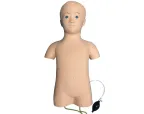The Children's thoracopuncture training model uses a variety of techniques and designs in simulating the real child's thoracoplasty structure to ensure its high degree of simulation and educational value. Here is a detailed explanation of how the children's chest puncture training model simulates the structure of a real child's chest cavity:

Material and form:
The models are usually made of high-quality polymer materials or silicone rubber, which are soft and realistic to the touch, and can simulate the softness and elasticity of a real child's chest cavity. The design of the model is also as much as possible to restore the shape of the real child's chest, including key structures such as ribs, sternum and spine, so that the trainer can intuitively feel the anatomy of the chest.
Anatomical details:
The model is very detailed in anatomy, including not only the main structure of the chest cavity, such as the lung, heart, large blood vessels, etc., but also the details of the soft tissue, nerves and blood vessels in the chest cavity. The precise simulation of these details helps trainers better understand the anatomy of the rib cage and improve the accuracy of puncture.
Simulated pleural effusion and pneumothorax:
The model can simulate the pathological state of pleural effusion and pneumothorax. By injecting gas or fluid into the pleural cavity, the model can form a simulated pneumothorax or pleural effusion, allowing the trainer to experience and learn how to deal with these pathologies in practice.
Puncture feedback system:
The model is equipped with an advanced puncture feedback system. When the trainer performs the piercing operation, the model can accurately sense the position and depth of the piercing needle and give corresponding feedback. If the puncture site is correct, the model will have obvious disappointment; If the puncture site is wrong, the model will issue a voice prompt, such as "The puncture site is wrong, and the nerve vessel is damaged!" . This immediate feedback helps the trainer correct mistakes and improve piercing skills.
Reusability and repairability:
The pediatric pleural puncture training model has the characteristics of being reusable and repairable. After careful design, the model can withstand multiple puncture operations without damage, ensuring the long-term use of the model. At the same time, if the model is partially worn or damaged, it can also be restored to normal use by simple repair or replacement of parts.
In summary, the pediatric thoracic puncture training model successfully simulates the structure and function of the real pediatric thoracic cavity through its high-precision material, detailed anatomical structure, ability to simulate pleural effusion and pneumothorax, puncture feedback system, and reusability and reparability, providing strong support for medical education and training.
